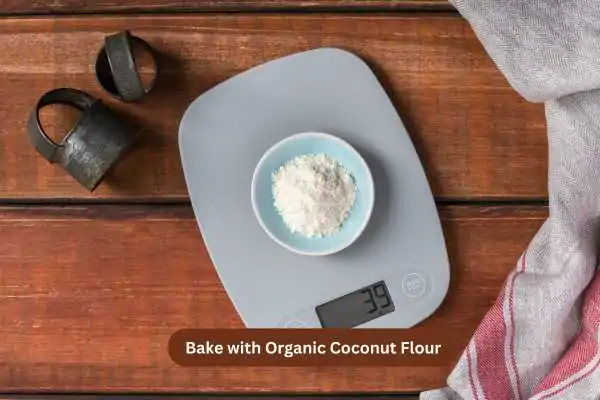Baking with organic coconut flour is becoming increasingly popular across the UK. This versatile, gluten-free alternative to traditional wheat flour is prized for its nutritional profile and unique baking qualities. However, if you’re new to coconut flour, you’ll quickly discover it behaves very differently from other flours. With the right guidance, you can transform your cakes, breads, and biscuits into wholesome treats packed with flavour and goodness.

In this guide, we’ll explore how to bake with organic coconut flour effectively, covering its characteristics, common challenges, and practical tips for success.
What Makes Organic Coconut Flour Unique?
Organic coconut flour is made from dried, ground coconut meat. It is naturally gluten-free, high in fibre, and low in carbohydrates, making it a favourite among people following gluten-free, paleo, or low-carb diets. Its mild, slightly sweet flavour complements both sweet and savoury recipes.
The most important distinction is its absorbency. Coconut flour soaks up a lot more liquid than wheat or nut flours. This means recipes often need more eggs, extra moisture, or a combination of both to achieve the right texture.
Key Benefits of Baking with Coconut Flour
-
Gluten-Free: Safe for coeliacs and those with gluten intolerance.
-
Nutrient-Rich: High in dietary fibre, healthy fats, and protein.
-
Lower Carb Content: A suitable option for individuals managing carbohydrate intake.
-
Natural Sweetness: Reduces the need for additional sugar in recipes.
-
Organic Quality: Free from synthetic pesticides and additives when sourced organically.
How to Substitute Coconut Flour
One of the most common mistakes bakers make is substituting coconut flour 1:1 for wheat flour. Because of its absorbency, this approach often leads to dry, dense results. Instead, follow these guidelines:
-
Use ¼ to ⅓ cup of coconut flour for every 1 cup of wheat flour in a recipe.
-
Increase liquid ingredients (milk, water, or plant-based alternatives).
-
Add 1 egg for every 30g (¼ cup) of coconut flour to provide structure and moisture.
If you’re new to baking with coconut flour, it’s best to start with recipes specifically developed for it. Once you gain confidence, you can begin experimenting with substitutions.
Baking Tips for Success
1. Measure Carefully
Coconut flour is light and fluffy, so spoon it into the measuring cup rather than scooping. Level it off with a knife for accuracy.
2. Increase Liquids
Because it absorbs moisture quickly, always add extra milk, water, or oil to prevent dry or crumbly textures.
3. Use Eggs for Binding
Eggs are essential when baking with coconut flour, as they help mimic the structure that gluten provides. If you’re vegan, chia or flaxseed “eggs” can also work, though the texture may be slightly denser.
4. Mix Thoroughly
Coconut flour tends to clump. Be sure to whisk it well into your batter or sift it before adding.
5. Allow for Resting Time
Let the batter sit for a few minutes before baking. This gives the flour time to fully absorb the liquid and prevents surprises once in the oven.
Popular Recipes Using Coconut Flour
Here are a few ideas to get you started with organic coconut flour in your UK kitchen:
-
Coconut Flour Pancakes: Light, fluffy, and naturally sweet.
-
Coconut Flour Banana Bread: A nutritious twist on a classic comfort food.
-
Coconut Flour Brownies: Rich and fudgy, with a subtle coconut undertone.
-
Coconut Flour Flatbreads: Perfect for pairing with soups, curries, or dips.
-
Coconut Flour Muffins: Ideal for a fibre-packed snack or breakfast on the go.
These recipes highlight the flour’s versatility while providing a healthier alternative to traditional baking.
Storing Organic Coconut Flour
To maintain freshness, store coconut flour in an airtight container in a cool, dark place. Because it is rich in natural oils, it can spoil more quickly than refined flours. For longer storage, keep it in the refrigerator or freezer. Properly stored, it can last up to a year.
Where to Buy Organic Coconut Flour in the UK
Organic coconut flour is widely available in UK supermarkets, health food shops, and online retailers. Look for certifications such as the Soil Association Organic Standard, which guarantees the flour is produced without synthetic chemicals. Buying in bulk can also save money if you plan to bake with it regularly.
Common Mistakes to Avoid
-
Using too much flour: Remember, less is more.
-
Not adding enough moisture: Always balance with liquids and eggs.
-
Expecting identical results to wheat flour: Coconut flour produces denser, more filling bakes with a distinct texture.
Avoiding these pitfalls will help you achieve consistently delicious results.
Final Thoughts
Learning how to bake with organic coconut flour opens up a world of healthier, gluten-free baking possibilities. While it requires some adjustments compared to traditional flours, the rewards are worth it: lighter, nutrient-packed bakes with a naturally sweet flavour.
Whether you’re making banana bread for the family, pancakes for a weekend brunch, or experimenting with muffins, coconut flour adds a wholesome twist to your kitchen creations. With a little practice, you’ll soon master the art of baking with this versatile ingredient.
By understanding its properties, making the right substitutions, and following tried-and-tested techniques, you can enjoy delicious, homemade treats that are as nourishing as they are satisfying.

